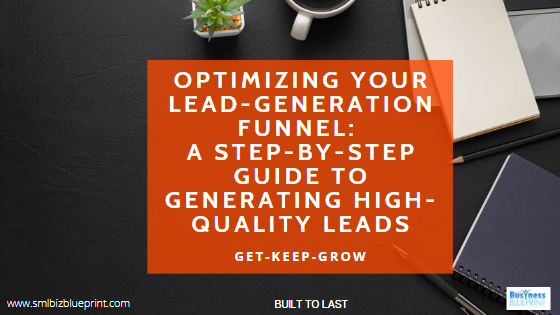As a business owner, you know that leads are the lifeblood of your online business.
However, generating high-quality leads can be a challenging and time-consuming task.
That’s where lead-generation funnel optimization comes in.
In this article, we’ll guide you through the process of optimizing your lead-gen funnel, so you can generate more high-quality leads with the same amount of time and/or money.

Step 1: Set Realistic Expectations
The first step in optimizing your lead-gen funnel is to set realistic expectations.
Optimizing a funnel is not as simple as just changing some stuff and seeing how it does. It requires a systematic approach to create long-term systems and processes for optimizing your funnels.
Start by asking yourself how much time your team can dedicate to testing and optimization and how many tests you want to run per month.
These questions will depend largely on the number of people on your team.
Step 2: Collect Critical Data
Before you start testing, you need to know what you’re going to test, why you’re going to test it, and the results you hope to achieve.
Look at each part of your lead-gen funnel and identify the following metrics:
Conversion Rate – This is the percentage of people who convert at each step of your lead-generation funnel.
Unsubscribe Rate – This is the percentage of people who unsubscribe from your email list with every email you send. The goal is to be under 0.5%.
Spam Complaint Rate – A high spam complaint rate indicates that you’re either generating low-quality leads or using shady email marketing practices.
Cost Per Lead – This is how much each lead costs you. Lower is better, but the amount you’re willing to spend will depend on how much money you make from an average customer.
Drop-Off Points – This is one of the most important metrics to look at. Where within your sales funnel are people dropping off?
Lead-To-Customer Conversion Rate – The end goal is not to generate leads but to make sales.
This metric indicates the quality of leads you’re generating and the quality of your primary sales funnels.
Once you have these metrics, you’ll have a good idea of what you want to optimize.
Step 3: Gather Scrollmaps and Clickmaps
Scroll maps and heat maps of your pages will give you a general idea of how people are engaging with your funnel.
Scroll maps show you where people are scrolling on a single page and where they’re not scrolling (i.e., where they start to lose interest).
Heat maps show you where people do and don’t click. These will give you a better idea of why something isn’t working.

Step 4: Create a Hypothesis
Use your marketing expertise and make a decision about what you’re going to optimize and how you’re going to try to optimize it.
First, figure out if you’re focusing on quality or quantity.
Lead Quality – If your lead-to-customer conversion rate is low, and if your unsubscribe rate is high, there’s a good chance that your funnel is generating low-quality leads.
Possible causes of that include:
Irrelevant Offer – This means that your lead-gen offer is attracting the wrong people.
Poor Primary Sales Funnel – You may be generating high-quality leads, but those people aren’t turning into customers because your primary sales funnel is ineffective.
Shady Marketing – Sometimes, a high unsubscribe rate or spam complaint rate means that people view your marketing practices as shady.
Lead Quantity – Assuming that your lead quality is good, it’s always a good thing to try and increase the number of leads you’re generating.
Possible causes of low lead quantity include:
Uninteresting Offer — If your offer isn’t super compelling to your target market, then people aren’t going to become leads.
Poor Sales Copy — Sales copy is an art form. And crafting compelling sales copy is sometimes quite difficult.
Lack of Urgency — People are procrastinators. If you’re not giving people a reason to take action right now, then they’re likely not going to.
Step 5: Create an A/B Test
Set a goal for what result you’re trying to achieve with the change.
You should know which metric you’re trying to improve and what a winner or loser will look like at the end of the test.
Here are a few things to keep in mind:
Statistical Significance – You’ll need to make sure that your results are statistically significant before you make a final call.
Random Variables – To avoid unclear results, make sure that all other variables (except for the change you made) stay as consistent as possible.
Set a budget and timeline for the test – How much money are you willing to spend on this test before you call it quits (in the all-too-common case that you get inconclusive results)?
How much time are you willing to give it?
Step 6: Give It Time
If you’re going to get results that mean something, then it’s going to take a bit of time (unless you have a big budget and are driving a lot of traffic every day).
So be patient.
Don’t announce a winner or loser when it’s still too early to call. But also don’t go over your predetermined budget or timeline, even if the results are inconclusive.

Step 7: Keep Testing
That’s the process.
Some of your tests will turn up exciting results, and you’ll learn a new trick for increasing the conversion rate or the quality of leads that your lead-gen funnel is driving.
Other tests won’t be very exciting; they’ll turn up inconclusive results that you can’t reliably pull any meaningful information.
That is all part of the process.
The important thing is that you keep testing, learning, and optimizing.
The more you do, the more you’ll improve the quantity and quality of your lead-generation efforts.
FAQs
What is a lead-gen funnel?
A lead-gen funnel is a process that takes a potential customer from their first interaction with your brand to becoming a paying customer.
It’s a series of steps that guide your prospect through the decision-making process, with the end goal of converting them into a customer.
Why is lead-gen funnel optimization important?
Lead-gen funnel optimization can have a massive impact on your business.
By optimizing your funnel, you can generate more high-quality leads with the same amount of time and/or money.
This can lead to increased revenue, improved customer acquisition, and higher profits.
How long does it take to see results from lead-gen funnel optimization?
It depends on the size of your business, the amount of traffic you’re generating, and the number of tests you’re running.
In general, it can take a few weeks to a few months to see meaningful results.
Optimizing your lead-gen funnel is a process that takes time and effort, but it’s worth it.
By following these steps, you can generate more high-quality leads with the same amount of time and/or money.
Keep testing, learning, and optimizing, and you’ll see the results in your bottom line.




